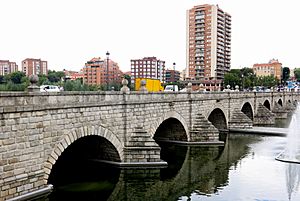Puente de Segovia, Madrid facts for kids
Quick facts for kids Bridge of Segovia |
|
|---|---|
| Native name Spanish: Puente de Segovia |
|
 |
|
| Location | Madrid, Spain |
| Built | 1582-1584 |
| Architect | Juan de Herrera |
| Official name: Puente de Segovia | |
| Type | Non-movable |
| Criteria | Monument |
| Designated | 1996 |
| Reference no. | RI-51-0009278 |
| Lua error in Module:Location_map at line 420: attempt to index field 'wikibase' (a nil value). | |
The Bridge of Segovia (in Spanish: Puente de Segovia) is an old and important bridge in Madrid, Spain. It crosses the Manzanares River. This bridge was officially recognized as a special cultural landmark in 1996. It is called a Bien de Interés Cultural, which means "Property of Cultural Interest."
Contents
Building the Bridge of Segovia
This famous bridge was designed by a well-known architect named Juan de Herrera. He worked for King Philip II of Spain. The king wanted a strong and beautiful bridge for Madrid.
When Was the Bridge Built?
Construction of the bridge started in 1582. It took two years to build, finishing in 1584. The bridge has nine large arches, called spans.
How Much Did It Cost?
Building the Bridge of Segovia was quite expensive for its time. It cost 200,000 ducats. A ducat was an old type of coin used in Europe.
What Is the Bridge Made Of?
The bridge is built from strong blocks of granite. Granite is a very hard and durable type of stone. This material helped the bridge last for hundreds of years.
Importance of the Segovia Bridge
The Bridge of Segovia has been a key crossing point in Madrid for centuries. It connects different parts of the city over the Manzanares River. Its strong design and historical importance make it a famous landmark.
See also
 In Spanish: Puente de Segovia para niños
In Spanish: Puente de Segovia para niños

